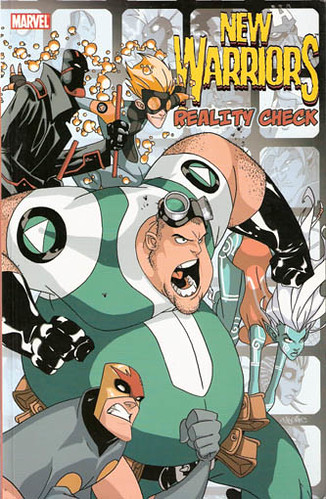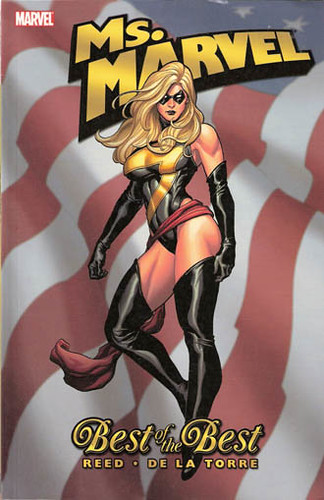Birds of Prey, v. 2: Old Friends, New Enemies
Collects: Birds of Prey: Wolves, Birds of Prey: Batgirl, Birds of Prey #1-6 (1997-9)
Released: 2003 (DC)
Format: 224 pages / color / $17.95 / ISBN: 9781563899393
What is this?: The second volume of the first go-round for Birds of Prey, in which Oracle (the paralyzed former Batgirl) and Black Canary fight crime and get their own ongoing series.
The culprits: Writer Chuck Dixon and pencilers Dick Giordano and Greg Land
I haven’t had much experience with the characters in Birds of Prey. Oh, I know Oracle used to be Batgirl before the Joker left her paralyzed, and Black Canary is perpetually romantically linked with Green Arrow. (Although I’m always hazy about whether she has sonic powers.) So I decided to try Birds of Prey, v. 2: Old Friends, New Enemies from James Madison University’s Carrier Library. What I found was something not earthshattering but something that felt like it deserved its long (for the time) run.
I was mostly curious about whether Old Friends, New Enemies would offer something beyond the high concept: two women, one wheelchair bound and the other an active agent, fighting crime. There are times, like the first story, Birds of Prey: Wolves, when it really doesn’t. Writer Chuck Dixon veers dangerously close to stereotypes of women at times: men are no good, women eat ice cream to cope, etc. Not that there aren’t women with these traits, but they do seem a bit pat.
 Dixon is determined to make Oracle an interesting and active — as active as he dares, at least — character. He succeeds, mainly, and Birds of Prey: Batgirl is one of the high points of the book. Oracle is captured by Spellbinder, who makes her hallucinate that she (as Batgirl) and Black Canary are fighting the Mad Hatter and the inmates of Arkham. This includes Joker, of course, who naturally triggers more than a little fear. But Oracle pieces together Spellbinder’s plan, outwits her, and then outfights her. I could do with Oracle giving herself fewer pep talks, but that’s a minor quibble.
Dixon is determined to make Oracle an interesting and active — as active as he dares, at least — character. He succeeds, mainly, and Birds of Prey: Batgirl is one of the high points of the book. Oracle is captured by Spellbinder, who makes her hallucinate that she (as Batgirl) and Black Canary are fighting the Mad Hatter and the inmates of Arkham. This includes Joker, of course, who naturally triggers more than a little fear. But Oracle pieces together Spellbinder’s plan, outwits her, and then outfights her. I could do with Oracle giving herself fewer pep talks, but that’s a minor quibble.
The main series works well. Oracle and Black Canary function as a team, although an uneasy one at times, since they’re still working out the boundaries of their relationship. Issues #1-3 feature Black Canary busting up a kidnapping ring in southeast Asia after being kidnapped; issues #4-6 introduces the Ravens, the Birds of Prey’s opposite numbers, and includes Kobra, time travel, a Russian satellite, and a real dinosaur in a Minnesota lake. It doesn’t take a genius to figure out which is more interesting.
The Ravens — Cheshire, Pistolera, and Vicious — steal the show, and quite frankly, I would read a Ravens series. (I’m sure I’m going to get an e-mail telling me about some Ravens limited series or one-shot or something. I don’t care. I’m sure my imagination is better than whatever was actually released.) The action is weird, high concept, and fun — it feels like some of the stuff Matt Fraction overreaches for in Punisher War Journal or Casanova. These issues make reading Old Friends, New Enemies worth it, although to be fair, there’s not an awful lot of stuff for the Birds to do while the Ravens do all the cool stuff.
Actually, Black Canary gets a fair amount of action, although little of it against the Ravens. Dixon seems to struggle for something for Oracle to do, and he fills it in with side plots introduced in the first three issues of the ongoing series. Someone has Oracle under surveillance, the Air Force is looking for a hacker, Oracle has an e-pen pal … and I don’t care about any of it. None of it is useful to the plot, and nothing comes of it. It’s annoying, as well, especially the Air Force officers, who are stepping over laws to track down the hacker … and there are no consequences. Blockbuster also hangs around the fringes of the story, and while I assume that pays off later, he mostly looms and looks menacing here.
Pencils are by Greg Land, except for Wolves, which is by Dick Giordano. Now, in 2008, if you have a comic featuring two female protagonists with a team of three female villains against them, the name “Greg Land” is going to come up when you discuss prospective artists. I don’t know if that was true in 1999, but Land does a good job. His cheesecake tendencies are nowhere near what they became later, and his admiration of the female form does not interfere with telling the story. There are more than a few panels with a scantily clad Black Canary, but given her default costume, that’s to be expected.
I wish there were more of this part of the series. There isn’t, though; only two volumes were released before the trades were renumbered to collect the Gail Simone issues. Still, Old Friends, New Enemies is worth picking up and perhaps buying the original stories in single-issue form.
Rating: ![]()
![]()
![]() (3 of 5)
(3 of 5)
Labels: 3, Birds of Prey, Black Canary, Carrier Library, Chuck Dixon, DC, Dick Giordano, Gotham City, Greg Land, Oracle, Ravens





 The failed second volume of the title has obviously had an effect on the team’s profile. They are now a joke — their old members (save Firestar and Justice) are slackers and underachievers, and when their leader, Night Thrasher, convinces them to reunite for a reality show, they add an even bigger loser to the team: Microbe is fat, smelly, socially awkward, and talks to microorganisms. If you revere the old days of the New Warriors, this is not for you.
The failed second volume of the title has obviously had an effect on the team’s profile. They are now a joke — their old members (save Firestar and Justice) are slackers and underachievers, and when their leader, Night Thrasher, convinces them to reunite for a reality show, they add an even bigger loser to the team: Microbe is fat, smelly, socially awkward, and talks to microorganisms. If you revere the old days of the New Warriors, this is not for you.  (3.5 of 5)
(3.5 of 5)  It’s a great starting point. Carol’s first move is to quit her job, become a solo hero, and hire a PR firm, which gives an idea of what she thinks it takes to become a famous hero. She needs more name recognition! And an archenemy! Who conveniently follows her through from the House of M universe, so that’s OK. But overall the strategy works about as well as you’d think.
It’s a great starting point. Carol’s first move is to quit her job, become a solo hero, and hire a PR firm, which gives an idea of what she thinks it takes to become a famous hero. She needs more name recognition! And an archenemy! Who conveniently follows her through from the House of M universe, so that’s OK. But overall the strategy works about as well as you’d think.  There are times the plot sags a little. The Brood is a good choice for Carol to fight, given her history with them — their attack triggered one of her transformations, into Binary — but the connection isn’t mentioned, which it should have been. Dr. Strange is taken out like a chump at one point, which is a let down. There’s a lot of reality and time hopping, which can be (and is, at times) confusing. As I said, Carol’s failing isn’t dealt with in Best of the Best, and I’m not sure whether it will be; I’m also not sure whether Carol’s somewhat callow exterior is something the reader is supposed to recognize or if it’s an unconscious insertion by the writer.
There are times the plot sags a little. The Brood is a good choice for Carol to fight, given her history with them — their attack triggered one of her transformations, into Binary — but the connection isn’t mentioned, which it should have been. Dr. Strange is taken out like a chump at one point, which is a let down. There’s a lot of reality and time hopping, which can be (and is, at times) confusing. As I said, Carol’s failing isn’t dealt with in Best of the Best, and I’m not sure whether it will be; I’m also not sure whether Carol’s somewhat callow exterior is something the reader is supposed to recognize or if it’s an unconscious insertion by the writer.  I remember reading most of these stories when they came out, back at the turn of the century, and thought they were, for the most part, forgettable. Putting aside the idea I can remember something as forgettable, it certainly felt it was not a worthy follow up to the storyline that ended The Twelve storyline once and for all. Having actually read what was in v. 1, however, I have to reappraise v. 2.
I remember reading most of these stories when they came out, back at the turn of the century, and thought they were, for the most part, forgettable. Putting aside the idea I can remember something as forgettable, it certainly felt it was not a worthy follow up to the storyline that ended The Twelve storyline once and for all. Having actually read what was in v. 1, however, I have to reappraise v. 2.